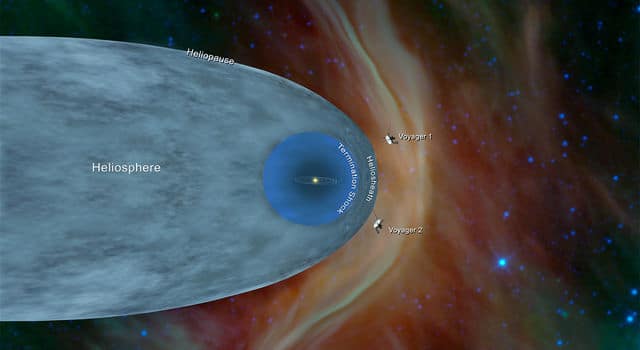Scientists from NASA who also worked during the Voyager mission are still hard at work going over information gained during that time and in recent times with the Voyager 2. Through all of their efforts, it seems something quite interesting has been brought forth.

NASA/Shutterstock
A mysterious boundary has been confirmed, while not many realize what this could hold for all of us others are quite blown-away. Because researchers are finally able to learn about the environment that Voyager 2 is traveling through right now, so much more than we could have expected is beginning to be known. The moment this aircraft broke through the heliosphere back in 2018 everything changed.
The heliosphere for those who do not know is the boundary or ‘wall’ being referred to above. This is what separates the local space we are present in with everything beyond. Getting through this boundary was the first step to truly leaving ‘home’ and figuring out what is beyond our solar system.
With at least five papers coming out regarding the findings noted through this research tons of things have been found. The Voyager 2 in itself was the second spacecraft ever to leave the heliosphere, and we should all be quite proud of those working at NASA making this happen. Getting through the heliosphere was no easy feat and for things to be going as well as they are still even a year after all was said and done, it is miraculous.

NASA
In regards to all of this NASA’s JPL website wrote as follows:
The Sun’s heliosphere is like a ship sailing through interstellar space. Both the heliosphere and interstellar space are filled with plasma, a gas that has had some of its atoms stripped of their electrons. The plasma inside the heliosphere is hot and sparse, while the plasma in interstellar space is colder and denser. The space between stars also contains cosmic rays or particles accelerated by exploding stars. Voyager 1 discovered that the heliosphere protects Earth and the other planets from more than 70% of that radiation.
When Voyager 2 exited the heliosphere last year, scientists announced that its two energetic particle detectors noticed dramatic changes: The rate of heliospheric particles detected by the instruments plummeted, while the rate of cosmic rays (which typically have higher energies than the heliospheric particles) increased dramatically and remained high. The changes confirmed that the probe had entered a new region of space.
Before Voyager 1 reached the edge of the heliosphere in 2012, scientists didn’t know exactly how far this boundary was from the Sun. The two probes exited the heliosphere at different locations and also at different times in the constantly repeating, approximately 11-year solar cycle, over the course of which the Sun goes through a period of high and low activity. Scientists expected that the edge of the heliosphere, called the heliopause, can move as the Sun’s activity changes, sort of like a lung expanding and contracting with breath. This was consistent with the fact that the two probes encountered the heliopause at different distances from the Sun.
The new papers now confirm that Voyager 2 is not yet in undisturbed interstellar space: Like its twin, Voyager 1, Voyager 2 appears to be in a perturbed transitional region just beyond the heliosphere.
“The Voyager probes are showing us how our Sun interacts with the stuff that fills most of the space between stars in the Milky Way galaxy,” said Ed Stone, project scientist for Voyager and a professor of physics at Caltech. “Without this new data from Voyager 2, we wouldn’t know if what we were seeing with Voyager 1 was characteristic of the entire heliosphere or specific just to the location and time when it crossed.”
It is also interesting to note that Voyager 2 as it passed through was able to confirm things from Voyager 1. For instance, the magnetic field in the region just outside of the heliopause is parallel to the magnetic field inside of the heliosphere itself. This also brings more questions to the table and coming across as quite the mystery.
NASA’s JPL also noted as follows on the topic:
The Voyager probes launched in 1977, and both flew by Jupiter and Saturn. Voyager 2 changed course at Saturn in order to fly by Uranus and Neptune, performing the only close flybys of those planets in history. The Voyager probes completed their Grand Tour of the planets and began their Interstellar Mission to reach the heliopause in 1989. Voyager 1, the faster of the two probes, is currently over 13.6 billion miles (22 billion kilometers) from the Sun, while Voyager 2 is 11.3 billion miles (18.2 billion kilometers) from the Sun. It takes light about 16.5 hours to travel from Voyager 2 to Earth. By comparison, light traveling from the Sun takes about eight minutes to reach Earth.
What do you think about all of this? I for one am excited to see what comes of all that we are facing. Perhaps we are closer to really discovering what’s out there than we might have expected.
